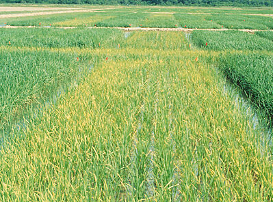
Nitrogen (N) Deficiency

Nitrogen deficiency is the most common problem in Asian countries. In particular, deficiency is occurred when new high-yielding varieties are sown without adding sufficient nutrients.
Nitrogen deficiency often occurrs at critial stages such as tillering and panicle initiation stages when nitrogen demand is large.
How to identify (symptoms)
Rice plants stunted growth. Reduced tillering. Old leaves and sometimes all leaves can become light green and chlorotic at the tips. Although young leaves are green, deficient old leaves become narrow, short, erect, and yellowish-green. Entire field may appear yellowish.
If nitrogen-deficiency is severe, old leaves turn to straw-color and die.

How to manage
1. Apply sufficient nitrogen fertilizer.
2. Do not apply large amount of nitrogen to less-responsive varieties. Hybrid rice absorbs mineral nitrogen more efficiently than inbred rice varieties.
3. Choose a suitable plant spacing for each cultivar
4. Apply suitable amount of nitrogen only when needed at each growth stage
5. Maintain proper water control; keep the field flooded to prevent denitrification but avoid N losses from water runoff over bunds immediately following fertilizer application.
6. Control irrigation and drainage properly to prevent nitrogen losses by running water after fertilizer application.
7. Control weed that competes with rice for Nitrogen.